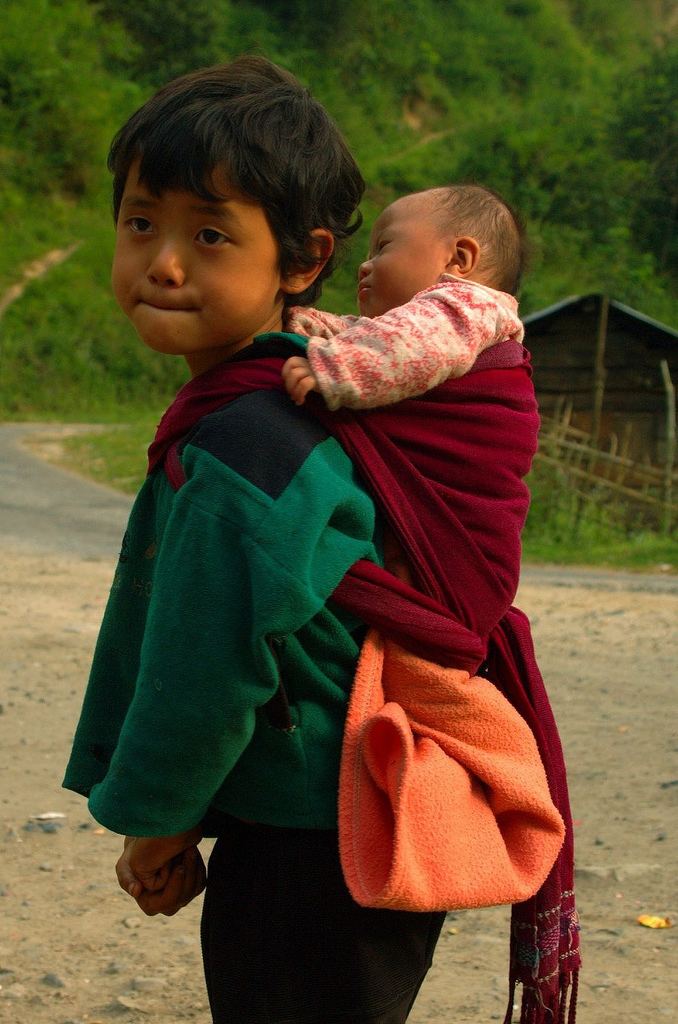1961 337,000 1981 632,000 2001 1,098,000 | 1971 468,000 1991 865,000 2011 1,382,611 | |
 | ||
The Indian state of Arunachal Pradesh has a total population of roughly 1.4 million (as of 2011) on an area of 84,000 km2, amounting to a population density of about 17 km−2 (far below the Indian average of 370 km−2 but significantly higher than similarly mountainous Ladakh). Much of Arunachal Pradesh is forested, and home to many of India's Scheduled Tribes. Such indigenous "tribal groups" account for about two thirds of population, while immigrants, mostly of Bengali/Hindi belt origin, account for a third.
Contents
As one of the Seven Sister States of eight if including Sikkim in India's remote north-east, it is culturally at least as much part of Southeast Asia as it is of South Asia; ethnolinguistically, it is divided between a Tibeto-Burman and Tai/Singpho/Tangsa areas bordering Burma area bordering Bhutan to the west, the Tani and Mishmi areas in the center and the Naga area to the south, bordering both Burma and Nagaland. In between there are transition zones, such as the Bugun/Aka/Hruso/Miji/Sherdukpen area, which form cultural "buffers" between the Tibetic Buddhist tribes and the animist Tani hill tribes. In addition, there are isolated peoples scattered throughout the state.
Ethnolinguistic divisions
Within each of these cultural spheres, one finds populations of related tribes speaking related languages and sharing similar traditions. In the Tibetic area, one finds large numbers of Monpa tribespeople, with several subtribes speaking closely related but mutually incomprehensible languages, and also large numbers of Tibetans. Within the Tani area, major tribes include Nishi, which has recently come to be used by many people to encompass Bangni, Tagin and even Hills Miri. Apatani also live among the Nishi, but are distinct. In the centre, one finds predominantly Galo people, with the major sub-groups of Lare and Pugo among others, extending to the Ramo and Pailibo areas (which are close in many ways to Galo). In the east, one finds the Adi, with many subtribes including Padam, Pasi, Minyong, and Bokar, among others. Milang, while also falling within the general "Adi" sphere, are in many ways quite distinct. Moving east, the Idu, Miju and Digaru make up the "Mishmi" cultural-linguistic area, which may or may not form a coherent historical grouping.
Moving southeast, the Tai Khamti are linguistically distinct from their neighbours and culturally distinct from the majority of other Arunachali tribes; they are religiously similar to the Chakmas who have migrated from erstwhile East Pakistan. They follow the same Theraveda sect of Buddhism. The Chakmas consist of the majority of the tribal population in Diyun Circle. Districts of Lohit, Changlang and Papumpare have a considerable number of Chakmas. They speak a linguistic variant derived from Assamese and Bengali. Assam also have a large population of Chakmas who reside in the district of Karbi Anglong, Nagaon and Kachar. They also exhibit considerable convergence with the Singpho and Tangsa tribes of the same area, all of which are also found in Burma. Finally, the Nocte and Wancho exhibit cultural and possibly also linguistic affinities to the tribes of Nagaland, which they border.
In addition, there are large numbers of migrants from diverse areas of India and Bangladesh, who, while legally not entitled to settle permanently, in practice stay indefinitely, progressively altering the traditional demographic makeup of the state. Finally, populations of "Nepalis" (in fact, usually Tibeto-Burman tribespeople whose tribes predominate in areas of Nepal, but who do not have tribal status in India) and Chakmas are distributed in different areas of the state (although reliable figures are hard to come by).
List of tribes
The Scheduled Castes and Scheduled Tribes Lists (Modification) Order (1956 and as inserted by Act 69 of 1986) lists twelve tribes of Arunachal Pradesh explicitly, but makes explicit that the list is non-exhaustive by noting that "all tribes of the State, including" those listed are to be considered "Scheduled". There are 26 major tribes and more than 100 sub tribes in Arunachal Pradesh. The twelve tribes listed are: Abor (Galo), Aka, Apatani, Dafla (Nishi/Nishing/Bangni), Galong (identical with Abor?), Khampti, Bugun (Khowa), Mishmi, Momba (Monpa), "any Naga tribes", Sherdukpen, Singhpo.
By ethnolinguistic classification:
Literacy
Literacy has risen in official figures to 66.95% in 2011 from 54.74% in 2001. The literate population is said to number 789,943. Number of literate males are 454,532 (73.69%) and number of literate females are 335,411 (59.57%).
Religion
According to the 2011 Indian Census, the religions of Arunachal Pradesh break down as follows:
"Others" refers to indigenous tribal religious traditions, such as Donyi-Polo (in the Tani area) or Rangfrah (further east). Tibetan Buddhism predominates in the districts of Tawang, West Kameng, and isolated regions adjacent to Tibet. Theravada Buddhism is practiced by groups living near the Burmese border.
Out of the 101 recognized tribes, 37 are having an animist majority (Nyishi, Adi, Galo, Tagin, Adi Minyong, Adi, Apatani. Bugun etc.), 23 are having a Christian majority (Wancho, Dafla, Mossang Tangsa, Bori, Yobin.etc.), 15 are having a Hindu majority (Mishmi, Mishing/Miri, Deori, Aka, Longchang Tangsa, Hajong, etc.), and 17 are having a Buddhist majority (Monpa, Khampti, Tawang Monpa, Momba, Singpho, Sherdukpen, Chakma.etc.). The remaining 8 tribes are multi-faith, i.e. doesn't have a dominant religion (Nocte, Tangsa, Naga.etc.).
